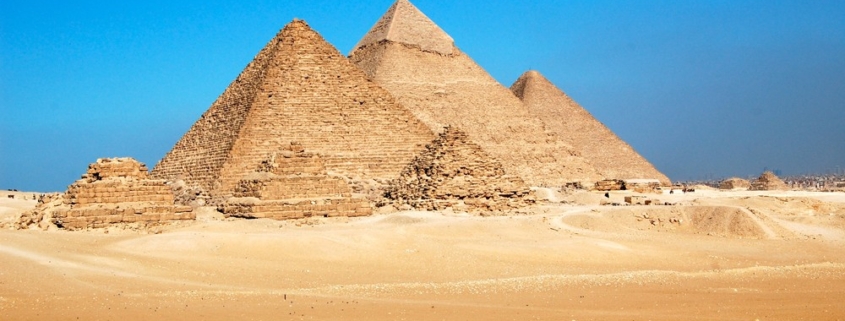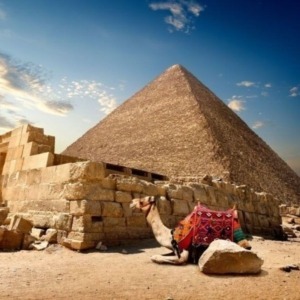Giza Pyramids (the secrets )
The Giza Pyramid Complex
, also known as the Giza Necropolis, is located on the Giza Plateau in Greater Cairo, Egypt. This site features the renowned
The great Pyramid of Giza , the Pyramid of Khafre, and the Pyramid of Menkaure, in addition to their respective pyramid complexes and the iconic Great Sphinx of Giza. These monumental structures were constructed during the Fourth Dynasty of the Old Kingdom of Ancient Egypt. The area also contains multiple cemeteries and the remnants of a worker’s village.
Situated at the boundary of the Western Desert, the complex lies roughly 9 kilometers west of the Nile River in Giza and about 13 kilometers southwest of Cairo’s city center.
The Great Pyramid and the Pyramid of Khafre are the largest pyramids built in ancient Egypt and have long symbolized Ancient Egypt in Western culture. The Great Pyramid was famously listed by Antipater of Sidon as one of the Seven Wonders of the World during Hellenistic times, and it remains the oldest and only surviving wonder.
The Giza pyramid complex includes the Great Pyramid (also known as the Pyramid of Cheops or Khufu), the smaller Pyramid of Khafre (or Chephren) situated a few hundred meters southwest, and the relatively modest Pyramid of Menkaure (or Mykerinos) even farther southwest. The Great Sphinx is located on the eastern side of the complex. Egyptologists generally agree that the Sphinx’s head represents Khafre. In addition to these primary structures, the site features smaller pyramids known as “queens” pyramids, causeways, and valley pyramids.
Khufu’s Complex:
Khufu’s pyramid complex includes a valley temple, now buried beneath Nazlet el-Samman village, connected to a destroyed causeway leading to the Mortuary Temple of Khufu. The king’s pyramid, completed in 2560 BC, is accompanied by three smaller queen’s pyramids and three boat pits, one of which contained the restored Khufu ship, now displayed at the Giza Solar Boat Museum. Some casing stones made of fine white limestone remain at the base of Khufu’s pyramid.
Khafre’s Complex:
Khafre’s complex features a valley temple, the Sphinx temple, a causeway, a mortuary temple, and the king’s pyramid. Several statues of Khafre were found in the valley temple, with notable discoveries made by Mariette in 1860 and later excavators. Khafre’s pyramid, completed in 2570 BC, appears larger than Khufu’s due to its elevated position and steeper angle, although it is actually smaller. It retains casing stones at its apex.
Menkaure’s Complex:
Menkaure’s pyramid complex includes a valley temple, a causeway, a mortuary temple, and the king’s pyramid. The valley temple once housed several statues of Menkaure. During the 5th Dynasty, an ante-temple was added. The king’s pyramid, completed around 2510 BC, has three subsidiary pyramids. Menkaure’s pyramid is the only one of the four major monuments without its original polished limestone casing.
The Sphinx:
Dating from King Khafre’s reign, the Sphinx had a temple dedicated to Hauron-Haremakhet during the New Kingdom, later expanded by subsequent rulers.
Construction Techniques of the Pyramids :
Theories on pyramid construction focus on the movement and positioning of large stones from quarries. Most suggest that the pyramids were built by dragging and lifting these stones into place. The Great Pyramid’s interior stones were likely quarried nearby, while its exterior smooth limestone was transported from across the Nile. The casing stones were meticulously cut and positioned to ensure symmetry.
Purpose of the pyramids:
The pyramids were likely built to house the remains of deceased Pharaohs. Ancient Egyptians believed that a part of the pharaoh’s spirit, known as the ka, remained with the body and required proper care for the pharaoh to fulfill his duties in the afterlife. The pyramid served as both a tomb and a storage place for items needed in the afterlife, protecting the embalmed body and aiding the pharaoh’s transformation and ascension.
Astronomical Alignment of Giza Pyramids:
The sides of the Giza pyramids are aligned with the cardinal directions to within a small fraction of a degree. Some theories, like the disputed Orion correlation theory, suggest the pyramids’ arrangement represents the Orion constellation.
If you willing one day to visit this amazing site check this link here for more details and special offers.
Written by ATW, Updated June 2024.







